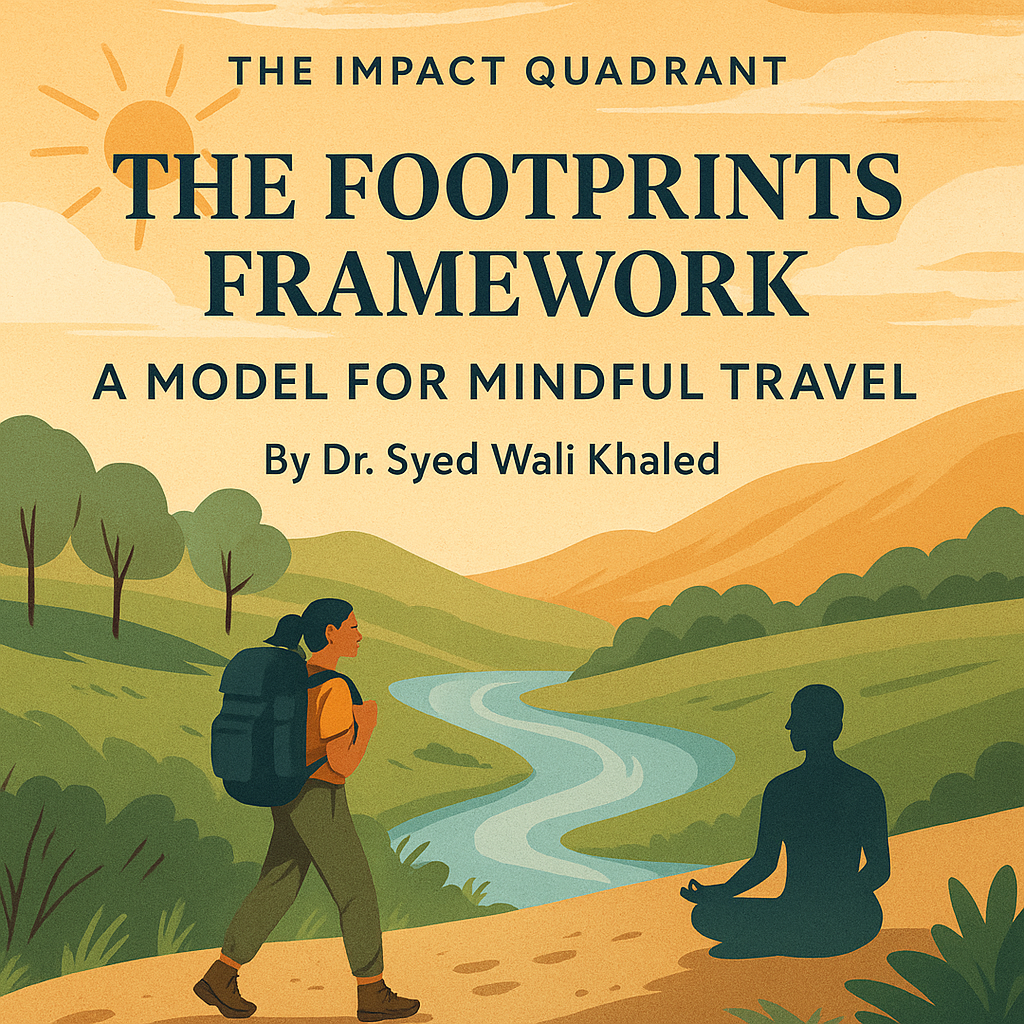The E-3 Footprints Framework: A Model for Mindful Travel
By Dr. Syed Wali Khaled | The Impact Quadrant
Abstract
The E-3 Footprints Framework, introduced by Dr. Syed Wali Khaled, provides a conceptual model for mindful travel by categorizing the impacts of tourism into three dimensions: Ecological, Emotional, and Existential footprints. This framework encourages travellers to adopt sustainable practices, foster cultural connections, and pursue personal transformation, aligning with the principles of experiential and sustainable tourism. This article expands on the framework, exploring its theoretical foundations, practical applications, and relevance to contemporary travel trends, supported by academic literature and industry insights.
Introduction
As global tourism evolves toward experiential and sustainable models, travellers are increasingly seeking journeys that offer meaning, connection, and personal growth (UNWTO, 2024). The E-3 Footprints Framework, proposed by the author, Dr. Khaled, offers a structured approach to mindful travel by classifying its impacts into three dimensions: Ecological, Emotional, and Existential footprints. This model not only guides travellers in making responsible choices but also aligns with broader trends in experiential tourism, such as wellness-focused travel, destination dupes, and regenerative tourism. This article provides a detailed exploration of the framework, its components, and its implications for travellers and destinations.
The E-3 Footprints Framework: Core Dimensions
The E-3 Footprints Framework is built on the premise that travel should be a co-creative process, where travellers and destinations mutually benefit. Below, each dimension is explored in depth, with examples and practical applications.
- Ecological Footprint
The Ecological Footprint dimension addresses the environmental impact of travel, emphasizing sustainability and regenerative practices. It encourages travellers to minimize their resource consumption and waste generation while supporting conservation efforts.
- Key Principles:
- Low-Impact Travel: Choosing transportation options with lower carbon emissions, such as trains or electric vehicles, and staying in eco-friendly accommodations like eco-lodges or carbon-neutral hotels.
- Regenerative Practices: Supporting initiatives that restore ecosystems, such as reforestation projects or marine conservation programs.
- Waste Reduction: Minimizing single-use plastics, recycling, and adopting zero-waste travel habits.
- Examples:
- A traveller visiting Costa Rica might stay in a solar-powered eco-lodge, participate in a beach cleanup, and offset their flight’s carbon emissions through a verified program.
- In New Zealand, tourists can join guided tours that fund native forest restoration, contributing to biodiversity preservation.
- Relevance:
- With tourism contributing approximately 8% of global carbon emissions (Lenzen et al., 2018), the Ecological Footprint is critical for mitigating environmental harm.
- Travelers adopting these practices can support destinations’ sustainability goals, aligning with global frameworks like the UN Sustainable Development Goals (UNWTO, 2023).
- Emotional Footprint
The Emotional Footprint focuses on the social and cultural impacts of travel, promoting empathy, connection, and mutual respect between travellers and host communities.
- Key Principles:
- Cultural Exchange: Engaging in authentic interactions with locals, such as participating in cultural festivals, learning traditional crafts, or dining with host families.
- Economic Support: Prioritizing local businesses, artisans, and guides to ensure economic benefits remain within the community.
- Respectful Engagement: Approaching cultural differences with humility and openness, avoiding behaviours that commodify or disrespect local traditions.
- Examples:
- In Rajasthan, India, travellers might join a village homestay, learning to cook traditional dishes with locals, fostering cultural understanding and supporting the local economy.
- In Peru, tourists can hire indigenous guides for treks to Machu Picchu, ensuring their visit benefits the Quechua community.
- Relevance:
- Cultural sensitivity is vital in an era where overtourism can strain local communities (Gössling & Hall, 2019). The Emotional Footprint encourages travellers to leave a positive social legacy.
- This dimension aligns with the rise of community-based tourism, which empowers locals and preserves cultural heritage (UNWTO, 2024).
- Existential Footprint
The Existential Footprint emphasizes travel as a catalyst for personal growth, introspection, and transformation, encouraging travellers to reflect on their experiences and evolve as individuals.
- Key Principles:
- Self-Discovery: Seeking experiences that challenge personal assumptions, such as solo travel or immersive cultural programs.
- Reflective Practice: Journaling, meditating, or engaging in guided retreats to process travel experiences and their broader implications.
- Transformative Learning: Pursuing educational or spiritual journeys that broaden perspectives, such as language immersion or pilgrimage routes.
- Examples:
- A solo traveller in Japan might participate in a Zen meditation retreat in Kyoto, reflecting on mindfulness and personal values.
- In Spain, walking the Camino de Santiago offers pilgrims a chance to contemplate life goals while connecting with fellow travellers.
- Relevance:
- Travel has long been recognized as a transformative experience (Lean, 2012). The Existential Footprint formalizes this by encouraging intentional reflection.
- This dimension resonates with the growing popularity of wellness tourism, projected to reach $1.2 trillion by 2027 (Global Wellness Institute, 2024).
Theoretical Foundations
The E-3 Footprints Framework draws on several theoretical perspectives in tourism studies:
- Sustainable Tourism: The Ecological Footprint aligns with sustainable tourism principles, which advocate for minimizing environmental harm and promoting long-term destination viability (UNWTO, 2023).
- Transformative Tourism: The Existential Footprint is rooted in transformative tourism, where travel fosters personal growth and global citizenship (Lean, 2012).
- Community-Based Tourism: The Emotional Footprint reflects community-based tourism models, emphasizing local empowerment and cultural preservation (Gössling & Hall, 2019).
These foundations position the framework as a bridge between academic theory and practical application, offering a holistic approach to mindful travel.
Practical Applications
The E-3 Footprints Framework can be applied by travellers, tourism operators, and destination managers to enhance the quality and impact of travel experiences. Below is a table summarizing practical strategies for each dimension:
|
Dimension
|
Traveler Actions
|
Operator Actions
|
Destination Actions
|
|
Ecological Footprint
|
Choose eco-friendly transport, reduce waste, support conservation projects.
|
Offer sustainable tour packages, use renewable energy, promote carbon offsetting.
|
Implement green policies, protect natural areas, certify eco-friendly businesses.
|
|
Emotional Footprint
|
Engage with locals, buy local products, respect cultural norms.
|
Facilitate cultural immersions, hire local guides, promote community-based tourism.
|
Preserve cultural heritage, support local economies, educate visitors on etiquette.
|
|
Existential Footprint
|
Reflect on experiences, seek transformative activities, pursue personal growth.
|
Design wellness retreats, offer reflective workshops, create educational tours.
|
Promote spiritual or educational sites, develop trails for introspection.
|
Alignment with Experiential Tourism Trends
The E-3 Footprints Framework complements nine emerging paradigms in experiential tourism, as outlined in related discussions (Khaled, 2024):
- Personalization and Predictive Modelling: Tailored itineraries can incorporate sustainable and reflective activities, enhancing all three footprints.
- Play Tourism: Gamified cultural experiences foster emotional connections with locals.
- Adventure and Outdoor Economy: Nature-based activities support ecological conservation and personal growth.
- Destination Dupes: Exploring lesser-known destinations reduces environmental strain and promotes authentic cultural engagement.
- Wellness-Focused Travel: Retreats and mindfulness programs align with the Existential Footprint.
- Blending Physical and Virtual Worlds: Virtual tours can educate travellers on sustainable practices before their trips.
- Solo Travel for Self-Discovery: Solo journeys emphasize existential growth and cultural immersion.
- Culinary and Regenerative Tourism: Sustainable food experiences support ecological and emotional footprints.
- Micro-Adventures: Short, local trips make mindful travel accessible, balancing all three dimensions.
By integrating these trends, the framework provides a versatile model for travellers to navigate the evolving tourism landscape.
Implications for Stakeholders
- Travelers: The framework empowers individuals to make informed choices, ensuring their journeys are sustainable, culturally enriching, and personally transformative.
- Tourism Operators: By adopting the framework, operators can design experiences that align with traveller values, enhancing satisfaction and loyalty.
- Destinations: Communities can use the framework to develop tourism strategies that preserve their environment and culture while fostering visitor engagement.
Challenges and Considerations
Implementing The E-3 Footprints Framework faces several challenges:
- Accessibility: Sustainable and transformative travel options may be cost-prohibitive for some travelers (Smith & Puczkó, 2015).
- Cultural Sensitivity: Ensuring emotional footprints are positive requires education to prevent cultural appropriation or insensitivity.
- Measurement: Quantifying existential impacts is subjective, requiring innovative evaluation methods.
Future research could explore metrics for assessing the framework’s effectiveness and strategies for making mindful travel more inclusive.
Conclusion
The E-3 Footprints Framework offers a compelling model for mindful travel, encouraging travellers to leave positive ecological, emotional, and existential footprints. By integrating sustainability, cultural empathy, and personal growth, it aligns with the principles of experiential tourism and addresses contemporary traveller priorities. As tourism continues to evolve, the framework serves as a guide for co-creating journeys that nourish self, society, and the planet.
References
- Global Wellness Institute. (2024). Global Wellness Economy Monitor Global Wellness Report.
- Gössling, S., & Hall, C. M. (2019). Sustainable tourism: A global perspective. Tourism Management, 71, 396–406.
- Lean, G. (2012). Transformative travel: A mobilities perspective. Tourist Studies, 12(2), 151–172.
- Lenzen, M., et al. (2018). The carbon footprint of global tourism. Nature Climate Change, 8(6), 522–528.
- Smith, M., & Puczkó, L. (2015). Health, tourism, and hospitality: Spas, wellness, and medical travel. Routledge.
- UNWTO. (2023). Sustainable Tourism Development: A Global Perspective UNWTO Reports.
- UNWTO. (2024). Tourism Trends: The Rise of Play and Immersion UNWTO Trends.
Share your Thoughts!
How will you apply The E-3 Footprints Framework to your next journey? Whether it’s choosing a sustainable destination, connecting with locals, or reflecting on your experiences, share your plans to inspire mindful travel.
#TheImpactQuadrant #FootprintsFramework #MindfulTravel #SustainableTravel #TravelWithPurpose










